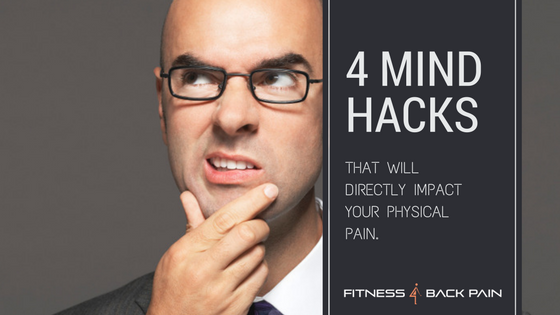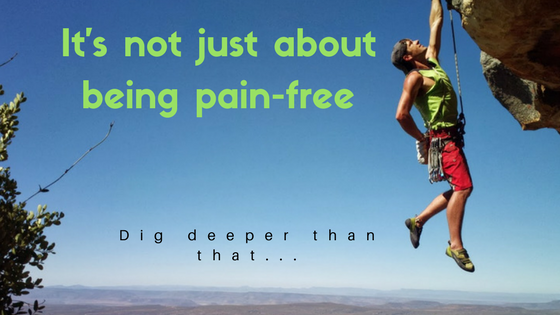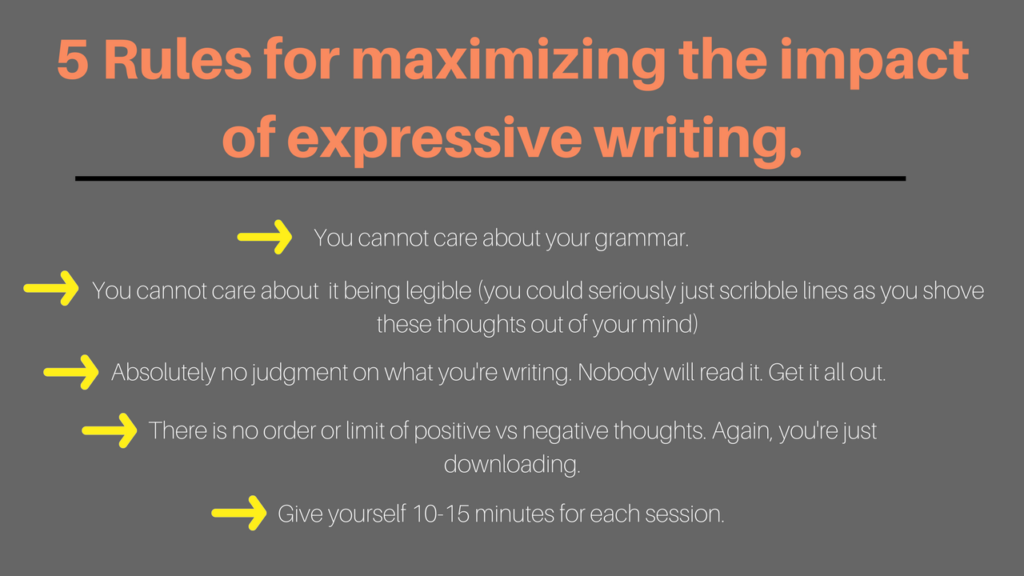
The power of the mind is a crazy thing. It can literally keep people in bondage, suffering from pain they waste time chasing their entire life. As a back pain sufferer, I want to address the mental side of pain and how refocusing and addressing some key areas can really make a huge difference in the way we recover and feel. I touched on this crazy deep topic a while back HERE.
Today, I want to give you the 4 most power mental shifts that I experienced on my own road to recovery and how you can implement them into your own life! If you don’t believe that the mind has any power on the body when it comes to how we experience pain, I want to make you a believer. Not by giving you a bunch of scientific crap but by giving you practical tools you can start to experiment with immediately to see results for yourself.
This is going to be a nice little write up, so I want to jump right in to these 4 points…Lets go!
(1) What is your goal?
Becoming “pain-free” isn’t enough. As simple as it may seem, it’s hard to measure when you’re going through the ups and downs of learning to use your body properly and move well. Even years after really getting a hold of my own lower back pain I still have flare-ups and weeks where I know I messed up. Does that make everything I have done worthless? Does the setback or flare up not allow me to celebrate the victories I have had?
Absolutely not.
I dealt with lower back pain for over 2 years before going to see a doctor. Then 2+ years after that I didn’t even start trying to rehab my own back and if I did I only had one foot in during the process. I never fully committed simply because I felt hopeless and not knowing where to start.
What changed for me was my focus around my WHY for getting more control over my pain. Of course, being pain-free is a great thing to strive for but it’s not going to keep you motivated.

Think deeper. Think greater impact. My whole life is my family. I want nothing more than to be able to engage with my kids as they get older. I want to run, climb and wrestle with them as much as they want. I didn’t want to be the dad who had to pass on activities due to a lack of control over my lower back pain. This freedom to move and play was my motivation. Of course I set up smaller goals along the way such as being able to do a dead bug without experiencing sciatica pain or train my lower body (I did a write up on this if you want to check it out! Part I and Part II) without feeling like I had been hit by a Mack truck for two weeks after.
Being consistent and paying close attention to how I used my body and what exercises I chose to help with my rehab was fueled by those specific goals. Without them, I would be wasting my time never really going all in and respecting the process.
How to turn your WHY into fuel for your recovery.
It’s not enough to simply think of what your best WHY is. It’s something that needs to become apart of who you are. An easy practice you can implement is to pick one big goal you want to see happen that you can’t do right now with your current pain.
What is that goal?
Write that goal down and place it in your top 4 most visited areas of your home/office. This goal is what will fuel your practice of proper hinging, better standing and sitting habits, better posture, safer exercises, healthier eating or will keep you plugged into the coaching program you have invested in or therapy you are currently doing.
You need fuel that will last.
Every morning, before you get out of bed and before you fall asleep at night review your WHY.
(2) Download and dump your thoughts.
The mind is such a powerful tool. Your mind drives the entire body and tells it what to do. From throwing a ball, writing a letter to even the smallest muscle contraction, your brain is the main driver behind these tasks. Believe it or not your brain and the way you process and store stressors play a massive role in how your lower back feels. This took years of convincing for me because I simply didn’t believe in “thinking” your way out of lower back pain. I am very much a black or white kind of person. To this day still, I believe that the majority of lower back pain is mechanical but the next biggest piece of that puzzle is how we process life and deal mentally with the stress we encounter.
A few years ago when I was living in Virginia I was working for a small chain of 24/7 gyms one of those being almost an hour away from home. I was constantly in traffic and I started hating the commute. After a few months of growing this internal frustration, I started experiencing an increase in lower back pain even though I was doing the same amount of prehab/preventative work if not more to make up for the increase of sitting time. It was getting worse and worse to the point where I started to double my dose of Anti-inflammatories and OTC painkillers.
It was brutal for a while.
After a little over a year, I was moved to a closer location to my home and it felt like a weight was lifted off my chest. A few weeks later I noticed I was thinking less about my lower back and was experience a significant decrease in pain. Even when I was stuck in traffic getting home I never experienced the pain the way I was with the less ideal situation.
This experience launched me into the study of the mind and how it affects the way we experience pain and how the way we process thoughts and daily emotions have a direct impact on that pain.
I don’t believe in thinking your pain away but I do believe that you can learn to address life and your thoughts in a way that can dramatically reduce it if not take it away completely.
Today, what has become one of the most impactful tools I have learned to implement is expressive writing. I picked this up from an awesome book by Dr. David Hanscom call Back In Control. This is basically a form of writing that consists of you downloading every thought that comes to your head whether negative or positive on paper. Once you have nothing else to think, you immediately rip up the paper, throw it away and go about your day. I do this 2+ times a day depending on how the day is going. Once at night and once in the am and if the day has been intense ill do it mid day.

What this is doing is giving your brain a place to put all these thoughts. Instead of being stuck in your head trying to manage these emotions and thoughts, you get them out and give your brain and nervous system a chance to chill. In order for this to be effective, you have to follow a few rules.

I can’t count the number of times where I have driven an hour into work and not even remember 75% of the drive. Simply because I am constantly wrestling with my thoughts both positive and negative. Now after doing this practice every morning, my mind is clear. Even if I try, my negative or worry based thoughts will not stick and tend to fade. For so long this had directly affected my bodies ability to recover in all aspects of fitness and injury.
Quick Tip: Don’t get this confused with journalling. There is a difference between the two. Often times your journaling consists of highs and lows from the day, gratitude and goals. The expressive writing I am describing is a total and complete mind dump that looks like nothing like anything you have ever written to be reread.
(3) Allow your changes to consume you.
“I don’t want to have to constantly be thinking about my posture”
“I don’t want to constantly be thinking about what exercises I can or cannot do”
“I don’t want to have to change the way I walk, sit or stand. thats too much work”
“I don’t have the time to always be thinking about how I am moving, Why can’t you just fix it”
 These are the people who want quick fixes they want the relief and the better feeling body but they have no desire to put in the work. They will give PT’s and Doctors thousands of dollars to push, pull and stretch their body thinking that 2-3 sessions a week will fix their problem.
These are the people who want quick fixes they want the relief and the better feeling body but they have no desire to put in the work. They will give PT’s and Doctors thousands of dollars to push, pull and stretch their body thinking that 2-3 sessions a week will fix their problem.
I was this person at one point in my life.
Of course, I didn’t want the pain and limited lifestyle. I wanted to be like I was “before it all happened”. I wasted a lot of money and a lot of time hoping someone else could give me the answer.
A good place to start is the way you sit, stand, hinge and walk. These need to be what is constantly on your mind until they become so deeply ingrained in your brain and body that you no longer have to think about it. You just do it. Changing the way you have used your body your whole life is hard work and it takes time. A lot of time.
You don’t make it to the Olympics by playing in a Rec. league on weekends. You practice and put to work what you are learning every single day, week in and week out. How did you get so good at your job? By showing up every single day week in and week out. After a couple of years you could probably do it with your eyes closed.
Apply this same structure to your body and I promise your life will be changed. Small baby steps every day lead to big changes over time.
(4) Forget what the doctor has told you.
Hi, my name is William and I ruptured my L5-S1 disc.
How do you categorize me after hearing that?
What thoughts are going through your head?
Maybe it’s
“Wow, maybe my little bulge isn’t as big as I thought.
or maybe
“I would take a ruptured disc, over a spine full of titanium rods and screws any day”
One of the biggest obstacles I still face with my students is what they have defined themselves as. There are so many “sufferers” who wake up every morning and put on this label that always has their diagnosis right next to their name.
Hear me when I say this.
There is freedom when you go from being just a “sufferer” to becoming a “student”.
A student embraces the process and learns from the mistakes that are inevitable. They take in and put to use every little lesson until it sticks. One step at a time they start to see a real change in their life and control over their pain.
The biggest mistake sufferers make is always introducing their diagnosis before introducing themselves. Your pain history can only give us a rubric to go off of to pull out potential triggers that you are repeating that keep you on what I call your “Pain Cycle”
Yes, you have a had a multi-level fusion, suffer from some level of scoliosis, have had surgery somewhere on your spine. That doesn’t mean you have less of a fighting chance than anyone else.
My biggest wish to anyone who sends me an email or asks a question is that they are coming from a place of willingness to learn the process and not just “whats the best exercise.”
I realize the world we are in. We want things fast. We want a handful of exercises that will beat our 10-year stint of lower back pain. We want the solution faster then we can type the questions.
Believe me, I know where you are coming from. I know what it means to crave out of desperation some kind of hope. hear me when I say, there is hope but it takes small shifts of your way of thinking to actually see the end results.
You have to wake up every day and cycle this thought through your head.
I dive into this even more in a controversial article a wrote a while back. You can check that out here.
No more “I can’t do (insert hobby or activity) because of my (insert personal back pain circumstance).
Instead, replace it with
What do I need to start doing TODAY so that I can start (insert hobby or activity) as soon as possible?
I know I know, this sounds like it’s coming from a self-help book published in the 60’s but guess what?
You will always be limited to what your mind tells you and your mouth speaks out. If you think you are too far gone, unfixable, undiagnosable or unrelatable your recovery will constantly drag on and everything you try will fail. Even if what your doing is what you should be doing. It will fail and you will be absolutely miserable.
I am not coming from a PhD in human psychology, i’m coming from real-world experience. This is raw un-cut truth from someone who drug their diagnosis around for years. A diagnosis that is not fixable without surgery.
The difference is, I beat it and I am 110% convinced that if I can do it, so can you.
Thanks for reading guys!
I want to hear from you: What is your WHY? What are you making your mental focus point for your own recovery?
Let me know in the comments below below!
William
p.s My goal for this site is to reach 1 million people who are struggling for practical solutions their chronic pain. Please share this any way that you can. Your support means the world to me! Thanks!


Thank you once again for an uplifting write up ! I have degen spine disease, spondylolisthesis with bilateral pars defect @ L4 -L5 . I had a failed back surgery Nov 2017 L5-S1 fusion with illiac bone replacing a disc that disintegrated . I how have buldging discs above my fusion , sacroliliac pain as well as sciatica pain constantly . I was a body builder prior to my fusion , didnt even know i had a back issue until mid last yr when i had lower back pain that didnt go away . So off to the doctor to find out my back is in a bad way . My focus is to get back into fitness. Its a long way off but it’s my goal to be able to train again . You inspire me to keep pushing in the right direction mate . Hats off to you ! Cheers Brad .
This is awesome Brad! I am excited for you! One step at a time and progress slowly. Any way I can help let me know!